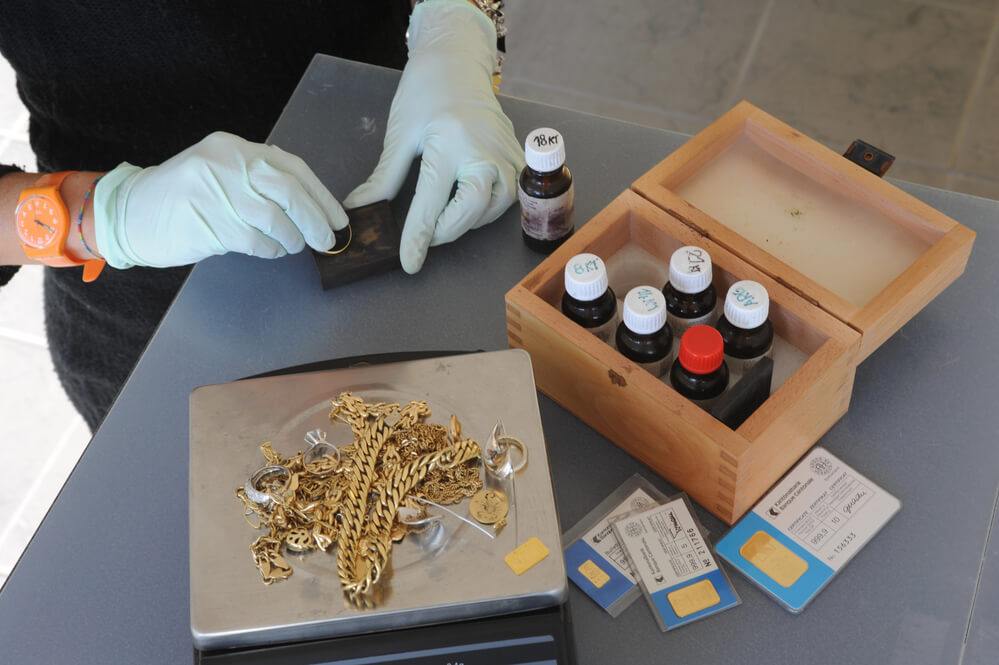Featured Image : Deposit photos
Gold, with its timeless allure and enduring value, has fascinated humanity for millennia. Whether adorning jewelry or serving as a symbol of wealth and prosperity, the purity of gold is of utmost importance.
In this enlightening guide, we delve into the captivating world of gold testing, uncovering the secrets behind professional laboratory methods and accessible at-home techniques.
Join us as we unravel the mysteries and nuances of assessing gold purity, empowering you to make informed decisions.
Understanding Gold Purity: A Karat-by-Karat Exploration
At the heart of gold testing lies its purity, often expressed in karats. Pure gold, denoted as 24 karats, is exceedingly rare in jewelry due to its softness. Instead, most gold items are crafted from alloys, blending pure gold with other metals to enhance durability and strength. Understanding the karat system is essential, as it reveals the percentage of pure gold in an item. For instance, 14 karat gold contains 58.5% pure gold, while 18 karat gold boasts a purity of 75%. Gold is valuable not only for its beauty but also for its enduring worth, making it a sought-after commodity for investment and adornment alike. Whether you’re buying or selling gold, recognizing its inherent value is key to navigating the market with confidence.
The Significance of Gold Testing: Assurance for Buyers and Sellers
In a market inundated with counterfeit and misrepresented goods, gold testing serves as a beacon of authenticity. For buyers, it provides assurance that they are investing in genuine gold, free from deceitful practices such as gold plating. Similarly, sellers rely on testing to safeguard their reputation, ensuring that their offerings are accurately labeled and authenticated. From jewelry enthusiasts to seasoned investors, gold testing is indispensable in fostering trust and transparency within the industry. When looking to buy or sell gold, ensuring its purity through reliable testing methods is paramount. This not only guarantees the value of your investment but also solidifies your credibility in the market. Whether you’re a buyer seeking genuine gold or a seller aiming to sell gold with confidence, trust in the reliability of gold testing for a seamless transaction experience.
Professional Gold Testing Methods: Precision and Accuracy Unveiled
X-Ray Fluorescence (XRF): Employing X-ray radiation, XRF analyzers penetrate the molecular structure of gold alloys, discerning the elemental composition with unparalleled precision. This non-destructive method offers swift and accurate results, making it a cornerstone of professional gold testing.
Inductively Coupled Plasma Mass Spectrometry (ICP-MS): Delving deeper into the molecular realm, ICP-MS dissects gold samples into ions, allowing for the detection of trace elements at minute concentrations. Renowned for its sensitivity, this method unveils the hidden intricacies of gold alloys, ensuring unmatched accuracy in purity assessment.
Electronic Gold Testers: Portable and versatile, electronic testers utilize conductivity variations to gauge the gold content of items swiftly. While not as precise as laboratory methods, they offer a convenient solution for on-the-spot testing, catering to the needs of both professionals and enthusiasts alike.
Embarking on At-Home Gold Testing Adventures
![]()

Source: Freepik
While professional laboratory testing sets the gold standard for accuracy, several simple techniques can be employed at home to assess gold purity:
Visual Inspection: Armed with magnification, enthusiasts can scrutinize gold items for telltale signs of authenticity. Solid gold exhibits a uniform color and texture, while plated items may betray their true nature through scratches and discoloration.
Magnet Test: Capitalizing on gold’s non-magnetic properties, this test distinguishes between genuine gold and magnetic alloys. Solid gold remains indifferent to the presence of magnets, providing a reliable indicator of authenticity.
Acid Test: Introducing dilute acid to gold samples can unveil impurities lurking beneath the surface. While pure gold remains unscathed, lower purity alloys may exhibit chemical reactions, shedding light on their composition.
Float Test: By submerging gold items in calibrated solutions, enthusiasts can gauge their density and purity based on buoyancy. Pure gold, with its lower density, floats effortlessly, while impure alloys may sink, betraying their true nature.
Deciphering the Karat Code: Understanding Gold Purity Ratings
Central to gold testing is the karat system, which elucidates the purity of gold items. From 24 karat pure gold to lower purity alloys, the karat rating provides insight into the composition of gold items, empowering buyers and sellers alike to make informed decisions.
In Conclusion
Knowing how to test gold purity is essential for both buyers and sellers in the jewelry market. Each karat rating tells you how much pure gold is in an item. This helps transactions be open and honest.
Through professional methods like XRF and ICP-MS, as well as accessible at-home techniques such as visual inspection and the float test, the authenticity of gold can be reliably verified.
Deciphering the karat code empowers individuals to make informed choices, fostering trust and integrity within the industry.

